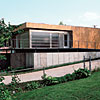The Hopes and Fears of Design-Build
The many faces of design-build
Despite the ethical and legal changes over the past 20-some years, and the growing preference for a single-source delivery method on the part of many owners, only 20 percent of AIA-member firms responding to the institute's 2003 firm survey indicated that they were offering design-build services of some kind at that time. Nonetheless, interest does seem to be growing among practitioners: With more than 8,000 members, the AIA's Design-Build Knowledge Community is the fourth largest of AIA's 25 interest groups. During his tenure as DBIA chair, Adams is encouraging other architects to get involved and learn more about design-build.
One of the first things architects need to understand is that there are many permutations of design-build. The service, for example, can be provided by a project-specific joint venture between an architecture firm and a contracting company, a single company that has both designers and builders on staff, or an individual developer, builder, or architect who subcontracts the other necessary expertise and skills for a given project. Thomas reports that even businesses with no historical connection to construction-such as accounting firms-have gotten into the act, serving as brokers by hiring all the other players.
According to ZweigWhite's 2005 survey, 55 percent of the firms' design-build projects were headed by a contractor; 26 percent were led by an integrated firm, which has both design and construction expertise in-house; 11 percent were led by designers; 5 percent by joint venture; and 4 percent by developers. It should be noted that the staff of the design firms in this survey are dominated by engineers, so currently very few design-build projects are actually spearheaded by architects.
The roles and influence of the architect can vary greatly from team to team, even among those that are structured similarly in terms of who holds the contract with the owner. According to Adams, "DBIA is not pushing one version. We'd like to get the designer into design-build. The architect does not have to be the lead, but must be at the table all the time."
Architect Steve Coxhead, senior associate at David Owen Tryba Architects (DOTA) in Denver, agrees: "As long as the contractor is sensitive to the design philosophy and intent, the quality can be just as good in a contractor-led project. The quality really has more to do with the relationship between contractor and designer."
















